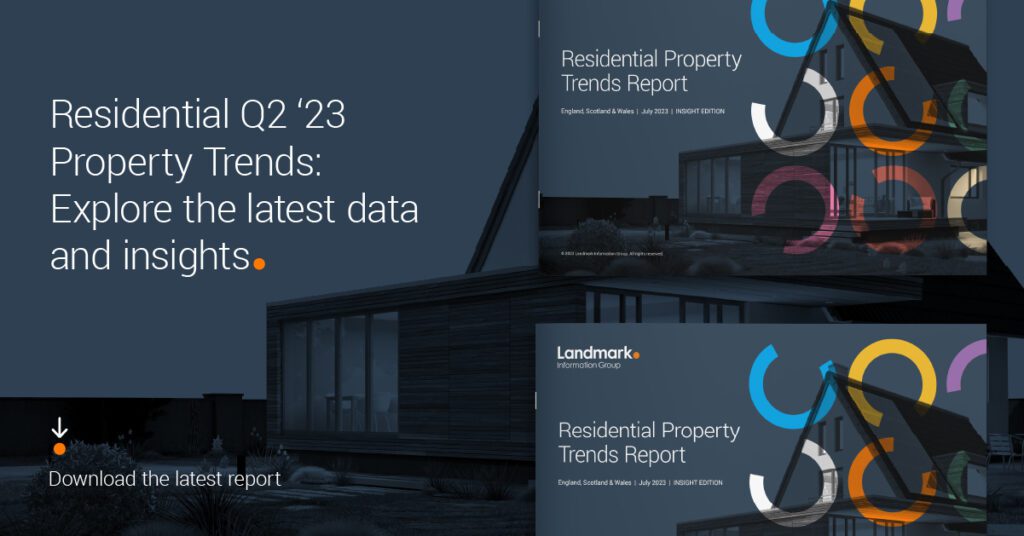In this second episode in our series celebrating a very special year for Millar & Bryce, Richard Hepburn, Director, Scotland discusses some of the big themes that emerged from our Property Excellence Past Present & Future Conference, to mark the firm’s 150th Anniversary, and how they relate to Millar and Bryce’s continued success in the marketplace.
Read the full transcript of Millar & Bryce at 150: Podcast Special below or listen to the episode on our Spotify channel, Landmark Talks Property.
(Podcast Host) David Lee (00:05)
This is the second episode in a series celebrating a very special year for Millar & Bryce, which is part of Landmark Information Group. We’re recording this soon after a conference to mark the firm’s 150th anniversary, Property Excellence, Past, Present and Future. I’m David Lee and I hosted the Millar & Bryce Conference and I’m your podcast presenter today.
(Managing Director, Millar & Bryce) Richard Hepburn (00:30)
and I’m Richard Hepburn, Millar & Bryce’s Scotland Director.
David Lee (00:34)
So today we’re discussing some of the big themes that emerged from the conference and how they relate to Millar and Bryce’s continued success in the marketplace. Richard, conferences are always a long time in the making, so were you happy that the event captured the essence of Millar and Bryce and lived up to its title of property excellence, past, present and future?
Richard Hepburn (00:58)
Hi David and good to pick up from where we left off in podcast one. The original premise of the conference was looking back, stroke, looking forwards. So for sure, reflecting on the Millar and Bryce business over the past 150 years, while also showcasing our direction of travel within a progressive technology driven group like Landmark, that’s finding solutions for land and property set to the future is what it was all about.
David Lee (01:27)
Great, and thanks Richard. And we’re not reviewing the conference, we’re not marking the speakers out of 10, particularly yourself Richard, of course, but instead we’re trying to pick out some key themes and reflecting upon them. So Richard, you talked to the conference about the foundational principles of Millar and Bryce that have been a golden thread to its long history. Can you tell (remind us) and tell listeners who weren’t at the conference what those foundational principles are?
Richard Hepburn (01:58)
David, we looked at what created the platform for the business to flourish. So although this isn’t an exhaustive list, it’s a combination of a few key elements working together, which I think have achieved that longevity and position as well for the future. So just picking up on a few of the key themes we looked at, clearly vision and leadership is particularly important and I think what came through strongly was the legacy of Moir Bryce who was the original founder, who established some search industry fundamentals which really created the industry that we work in today, not just Millar and Bryce. I certainly think part of his energy and direction flows through to a second theme, and that was around influencing and networking, where he established principles with the legal profession in Scotland, which remain intact to today.
We then went on, I think, to look at culture, another key element, and a workplace which sets challenges, but also allows a bit of freedom for fun outside work. That came through in lot of the research we did. Resilience and reinvention. I mean, I think that’s probably a pretty obvious one, is if we stayed running the same business processes from 1875 I don’t think we’d last very long in 2025. Then finally, financial stability and management probably goes without saying as well. I think we kind of recognise that it’s important to have shareholders who see the need to reinvest in a business to help it to undergo that innovation.
David Lee (03:39)
Great, thanks Richard and we’ll pick up on some of those points as we continue our discussion and again, you said at the conference when you were considering coming to Millar & Bryce that it had been described by somebody as a bit of a dusty old business but you found something quite different when you arrived at the firm and in terms of that vision and leadership, what did you find and what have you brought in your tenure as Scotland Director?
Richard Hepburn (04:08)
So I think saying that when a business is 150 years old, I’m really conscious that I’ve only been here eight years and I’m really the custodian of a legacy for a period in time. So for me it’s about preserving the best of what’s gone before but also recognising the need to identify and execute on change where that’s needed which is really what goes to create a sustainable future. So I’d say that over Millar & Bryce’s 150 years, there have been a number of inflection points and we talked about these in the conference, some driven by external economic factors, wars for example, and from things like changes in technology. I’d say my contribution if I was putting that on my tombstone would be really seeing the virtual elimination of paper from our core production processes and that really came on the back of investment from Landmark which brought in cloud-based technologies. And that’s really what helped us get through COVID and allowed us to move to a virtual working model, I don’t know what we’d been like with all the paper we’d had in 2017.
David Lee (05:19)
Thanks Richard and to pick up on another point, another of those foundational principles, influence and network, why is that so important?
Richard Hepburn (05:29)
So I’m going to pick up on something that my colleague Lorna Kerr mentioned at the conference in her section and that’s really the vital role played by trusted partnerships and why that influence and network within the property world really has been a foundation for Millar & Bryce throughout its history. And I think the conference showed that that still exists. Clients were at the conference who’d worked with Millar & Bryce for 20, 30, 40 years and more. And we know we’ve got some that have been with us for the entire 150-year journey.
David Lee (06:03)
I guess quite closely linked to that, Richard, is this idea of culture because people don’t do business with firms who haven’t got their own internal culture right. So what is it that makes Millar and Bryce what it is today in 2025, 150 years on, in terms of its culture and in terms of its values?
Richard Hepburn (06:23)
I think without a doubt some of that goes back to Moir Bryce again and the standards and approach to work he brought but also what he did outside work which I think came through in some of the things we read about how involved people were in other activities. I think also the involvement of the Bryce family generally for more than the first hundred of our 150 years reinforced that as well. But I think one of the key things we talked about at the conference was this importance of multi-generational staff passing on knowledge and expertise and I think that’s where longevity of staff really counts. So we’ve still got a number of 40-year veterans in the business today and I think, you know, we talked to the conference about from a customer point of view, we’ve got 550 years of combined Sasine search experience and that’s unmatched in the market and that’s why we really do remain a trusted partner for many customers. So I do think that despite changes of ownership and now being part of a larger group, that there’s still a family business feel which has been there from the start.
David Lee (07:35)
And you touched on that sort of periods of change in ownership. And I think another foundational principle is this financial stability and management and that persisted for a very long time in Millar and Bryce’s history with that strong family thread running through. But then there was a challenging period when it was seen as a little bit of a cash cow by its owners and the pension funds were depleted. But now it’s back in that wider Landmark Information Group cutting across the whole property sector, stability seems to be back.
Richard Hepburn (08:08)
Yeah, I mean, we definitely had a period after the end of family ownership when essentially financial investors took control of the business and really showed by their inaction the sort of importance that having owners who are committed to what the business does is more important really than the profits it generates. So I think the acquisition by Landmark in itself, already a group which understood property lawyers and their challenges, it really did help bring Millar & Bryce back on track. I think their vision for a digitally enabled future does bring opportunity for our business in Scotland to take the best of solutions designed for the market south of the border and adapt them for the nuances of our situation up here.
David Lee (08:57)
Okay, and the foundation stone I’m going to come to last Richard deliberately is one that you said was maybe a bit of a given, but it’s so important. It’s that resilience and reinvention, the ability to change with the times. And you described how Millar and Bryce has always been at the front of technological changes. Tell us how that’s manifested itself in its history.
Richard Hepburn (09:19)
Okay, well we know from our research that Millar & Bryce was the first firm of its kind to have a telephone in 1905, the first to have a fax machine and similarly with the introduction of typewriters and word processors when they became available. But more recently, the use of robotic processing technologies I think has really helped improve workflows and customer experience and allows searchers really to deploy their skills more in analysis and investigation rather than in some of the more mundane report production tasks. But now as we look ahead and with the support of skilled data analytics experts in Landmark, we’re really examining where and how the use of AI can benefit our business. So it is important to embrace change. I think we’ve got an important warning or, I guess, watch word from Chris Loring of Landmark at the conference really to mind the gap between the data and the delivery. It’s great to innovate and make progress constantly, but make sure the underlying data is sound and trusted and that your decisions are good. That’s what good business practice and resilience is all about.
David Lee (10:31)
Okay, and coming back to that great double actor, Richard, Gary Donaldson and Lorna Kerr, they talked at the conference about serving clients with honesty, authenticity and technology. And Lorna talked specifically as you’ve touched on about blending those trusted partnerships with end-to-end digital systems. So why are those trusted partnerships and those digital systems both so important, both individually and together?
Richard Hepburn (11:00)
Gary and Lorna were a great double act at the conference and I think what they emphasised again was that it’s vital to get that balance between the technology and the people. And that’s something Millar & Bryce has always done well as we noted earlier. As Yayoi Teramoto, whose Landmark’s Data Scientist said at the conference, Landmark Information Group is fully embracing AI, but only where it can deliver clear benefits in the process. It can’t be used as a blunt instrument. And as Yayoi clearly said, you still need the human in the loop.
David Lee (11:36)
Okay, thanks, Richard. we’ll come back to that technology and people theme later, sticking with AI for now, William Ullstein, the CEO of polling organisation, YouGov, gave a tremendous presentation at the conference, really fascinating use of real life data from real life people. And he had some interesting things to say about the property buyers of the future, especially around technology and AI.
Richard Hepburn (12:01)
Yes, as you might expect, those born after 1997 or Gen Zs were born into and have grown up with technology as a fundamental part of their life, the so-called digital natives. So Gen Z really are more open to AI than older generations. And as Will said, 50 % are saying they’re using AI chatbots every week. 83 % of 18 to 24-year-olds have used a chatbot compared to 31% of 50- to 64-year-olds and only 19 % over 65. So yes, big changes are happening.
David Lee (12:39)
What Will also said, Richard, which was also very interesting, is that it’s a more nuanced picture even among the younger generation when it comes to using AI for legal advice.
Richard Hepburn (12:50)
Yes, I mean his polling data showed that just 18 % of 18- to 24-year-olds think it was a good idea to use AI for legal advice, with 54 % saying it was a bad idea and 28 % who didn’t know. I do though think there’s something maybe a bit reassuring in that. So when it comes to one of the bigger decisions in life, like buying a house, younger people still want advice from someone who looks bit like their mum or dad rather than trusting the technology. And one really surprising finding was that while 20% of all ages trust AI now, this falls to 17% trusting future uses of AI. Again, it’s all coming back to using AI as a tool and keeping the human in the loop.
David Lee (13:44)
And what else did Will tell us Richard about that property buyer of the future?
Richard Hepburn (13:50)
Well, they definitely see climate change as the biggest global threat and really care about their environment and that came through really strongly. Leading on from that, they want to do business with organisations who share those values and I think that’s a key message for those setting standards, and particularly in Scotland, where consumers don’t routinely have the same diligence around climate, flood, for example, as exists in England even today.
So what was also clear though was that they want technology to be at the heart of the property buying experience.
David Lee (14:28)
So does that mean Richard that properties will be sold entirely digitally in future do you think? Right from the viewings at the beginning to signing off at the end?
Richard Hepburn (14:38)
Well, I think I would think that that’s a while away and I think that definitely came through from our panel session at the conference. We heard about people viewing homes via high quality video and use of things like immersive headshot technology. Alan Cumming of Retti, one of the panellists thought this would just help reduce the number of interested parties and that serious buyers would still view in person and interestingly, still pick the phone up to talk to someone about it. Lindsay Gowans from DHKK surveyors agreed with Alan and really confirmed that in her opinion you had to see and feel a house to value and market it accurately. Then finally, Jill Andrew from Connell & Connell, a Conveyancer, still thinks the human touch matters massively in an industry where property purchase and sales are often caught up in highly emotional life events; couples moving in together, houses being sold if parents move in to care or die. She said this really requires human interaction. So it was really touching to see how our property panel of Alan, Lindsay and Jill were also motivated by this idea of giving clients a really personalised and human experience.
David Lee (15:59)
Absolutely. And again, Richard, that brings us back to that balance of technology advancement and human connection, because there was a little bit of frustration with the slow pace of technology in the property sector that was voiced at the conference.
Richard Hepburn (16:14)
Yeah, that’s very much so. I mean, Ann Stewart, one of our other presenters at the conference, bemoaned the slow pace of adoption of e-signatures and digital identities and really did implore everybody to move much faster. Alan Cumming again said that we had to cut out duplication in areas like Know Your Customer and Anti-Money Laundering checks, very often these have to be done several times and the client ends up paying much more because the information cannot be shared. There really has to be a place where that information can go and estate agents, conveyors, surveyors and lenders can all access it securely.
David Lee (16:56)
Indeed, really kind of rich discussions at the conference, Richard. So how would you sum it up and what it says about the place of Millar and Bryce in the market in 2025, 150 years after the firm was born?
Richard Hepburn (17:14)
It was a fantastic day and I think really I’d come back to in summary those foundation stones, but especially to those trusted partnerships and that ability to innovate and change over time. That brings resilience and reinvention. We’ve managed to survive and thrive for 150 years and with the support of Landmark I’m confident we can continue to reinvent ourselves successfully with that combination of trusted human partnerships and constant technological innovation.
Share this post on social media
Our services
Estate Agency Services
Residential Conveyancing
Land and Property
Commercial Real Estate
Private Client
Integrated Search & Order Solutions
What makes the Scottish property transaction process more effective than our counterparts in England & Wales.
Landmark’s Property Trends Report for Q3 2024 is now live, providing an in-depth analysis of developments in the residential sector. Richard Hepburn, Managing Director of Millar & Bryce, explores the current market trends presented in Landmark Information Groups’ Q3 property trends report.
In our latest quarterly Property Trends Report from parent company, Landmark Information Group, presenting July-September 2024 data on listings, Sold Subject to Missives, completions and registered sales, Scotland’s figures offer a valuable perspective in comparison to the rest of the UK. Completions were down just 13% in Q3 2024 vs Q3 2019 (the last ‘normal’ pre-Covid benchmark year), which contrasts sharply with England and Wales – where completion volumes were down 42% – indicating that Scotland’s streamlined transaction process working more efficiently.
So why are property transactions more likely to be successful in Scotland?
Devolved matters; Scottish Parliament
Across the UK, the uncertainty over mortgage rates and the new Labour Government kept the brakes on the residential market. In Scotland, as land and property related matters are devolved to the Scottish Government, the implications from ongoing political unrest have had less of an impact.
Richard says, “Whilst some sellers and buyers in Scotland might have been holding off to see what beneficial changes the new UK Government will make the fact that some key levers in the property space are controlled by the Scottish Government (transaction taxes, first-time buyer incentives) means, we may not see the same profile of activity going forward.”
As prospective buyers paused ahead of the Budget in the hope of more favourable interest rates, residential listings remained high, and the presence of sub-4% interest mortgage deals started to create more seller and buyer confidence.
Continuing, Richard commented, “One other factor in the mix is the first new Labour Government Budget. Down South, there has been the sense that some buyers have held off to see if there are any property tax changes to come before acting. This might have lesser impact on us with property taxes set locally by the Scottish Government. The SDLT changes from Spring 2025 in England & Wales announced in the 30th October budget won’t impact Scottish buyers but it remains to be seen what changes the Scottish Government might announce in the 4th December Scottish budget.”
While the expected November 0.25% base rate interest rate cut to 4.75% has gone ahead, uncertainty remains with major UK lenders increasing mortgage rates and predictions that these will remain at this raised level for some time on the back of , with some measures in the October 30 budget .
Home Report
Earlier this year, Richard commented on the ‘dynamic’ of Scotland’s transaction end-to-end pipeline and market that allowed a more efficient transaction process with quicker turnaround times.
In Scotland, we have the well-established Home Report at the beginning of every listing process, mandatory under Scottish Government requirements. This also satisfies many of the up-front information requirements under the National Trading Standards Material Information rules that came into force in the Autumn of 2023. Their ask is simply to ensure that sufficient transparency is given on all ‘material information’ to prospective purchasers right at the start, avoiding them wasting time and money in considering a property that may not be suitable for them. These extend to items not typically included in the Home Report currently such as flooding, property rights (ie. access) and impact of coal mining. Flooding is a good example of a forward-looking risk which is not covered off in the current transaction process in Scotland but may in the future be impacted by the effects of climate change for example.
Richard continues: “To further compliment the current Home Report, Landmark Scotland has developed a Supplementary Report with the aims to further close the gap in satisfying the Material Information requirements, providing the additional, property specific, information needed to comply with parts B & C of the rules”.
Whilst overall we don’t have the same transaction delays as in England and Wales, with the Home Report already recognised by National Trading Standards as being pretty close to the levels of up-front transparency they require, this supplementary information completes the picture.
Q4 Insights
Richard commented, “As economic factors continuing to stabilise and Scotland’s efficiencies in home buying and selling make for a more streamlined transaction process – the outlook for Q4 and into 2025 is looking more positive. A healthy residential property market is a proven factor in improving the economy overall.”
Download our report
For more in-depth insights, check out our Q3 2024 Residential Property Trends report today.
Share this post on social media
Our services
Estate Agency Services
Residential Conveyancing
Land and Property
Commercial Real Estate
Private Client
Integrated Search & Order Solutions
As of April 2024, the number of open cases in the Registers of Scotland’s backlog exceeds 119,000, with the oldest case dating back to January 2018.
While homeowners are not restricted from selling, remortgaging or making changes to their land or property title whilst the application is open, it can create unnecessary additional time, effort and sometimes costs for solicitors.
More worryingly we have recently seen a number of occasions where standard securities that were recorded in the Sasine Register have not been discharged as part of the First Registration and solicitors acting in any subsequent transactions are not aware of their existence when following normal practices, until the application makes it out of the backlog!
Once a property moves to the Land Register, there is no need (in theory) to look at the Sasine Register. A Legal Report for a property that has left the Sasine Register will only report on the Land Register title or pending application(s). If the parties acting in the first registration have failed to satisfy their obligation to discharge an outstanding standard security, then this won’t be apparent in normal practice.
We can help mitigate the risk of the above situation. If a property is undergoing first registration, we can send the legal report as normal. However we can also make you aware and arrange an unregistered legal report. We can examine the evidence of the original, identify the sasine search sheet and provide an unregistered legal report over the sasine title(s) making sure there are no surprises when you receive your completed title sheet.
At Millar & Bryce we’re here to help, as well as being experts on searches, we understand your requirements for conveyancing and registration and provide pro active solutions to mitigate risks in transactions.
If you’d like further details, then please contact your Account Manager or email us at relationship@millar-bryce.com
Share this post on social media
Our services
Estate Agency Services
Residential Conveyancing
Land and Property
Commercial Real Estate
Private Client
Integrated Search & Order Solutions

Landmark property Trends Report - Q2 2023
A subdued market struggling with uncertain conditions
The residential sector is still navigating a period of uncertainty. Although listing activity has strengthened this quarter – with June ‘23 outperforming June ’19 by 10% in Scotland and 12% in England & Wales – demand remains weak with volumes struggling to progress through the transactional pipeline.
Overall, this trend is likely due to ongoing high interest rates, restricted mortgage availability and affordability being squeezed as the cost-of-living crisis continues to impact the sector.
As a result, our report shows lower volumes have been feeding through to the rest of the transaction pipeline. In Scotland, the market seems to be more resilient. When compared to Q2 2019 levels, our data found that STTM levels were down 10%, completion activity reduced by 13% and registered sales dropped by 11%.
In England and Wales, if we compare the same period in 2019, SSTC volumes were down 30%, residential search order levels dropped by 32% and completion volumes were reduced by 39%.
Landmark CEO Simon Brown commented:
“While there is strong supply in the residential market, the sector continues to be impacted by the cost-of-living-crisis, with mortgage availability and then affordability limiting consumers’ ability to move. We will only see activity flow through the pipeline once the market finds a balance between interest rates, inflation and the cost of housing. When that time comes, speeding up property transactions – which now take an average of 133 days in England and Wales – will be essential to ensuring a swift and sustained recovery.”
Click here to access the Cross-Market Activity edition of Landmark’s Q2 2023 Residential Property Trends report.

NB: In order to benchmark pipeline performance, this report compares our latest data with 2019 as the last ‘normal’ trading year.
At Millar & Bryce our approach to corporate social responsibility (CSR) reflects the steps that we are taking to ensure we are, and remain, a good corporate citizen. Social responsibility encompasses everything we do that has an impact on society around us – it is our values and behaviour as an organisation. We recently partnered with AAI Employability on an innovative workplace initiative called Graduating Communities as part of our ongoing commitment to supporting third sector organisations around us. Through this partnership we were able to second one of our colleagues for three months to the Social Bite Village.
The pilot placement was a huge success and has laid the foundation for an ongoing programme with the Social Bite Village. We look forward to working on many new initiatives into the future supporting local projects.
Share this post on social media
Our services
Estate Agency Services
Residential Conveyancing
Land and Property
Commercial Real Estate
Private Client
Integrated Search & Order Solutions
In a time of extreme uncertainty due to the ongoing changes imposed as a result of COVID-19, Millar & Bryce and DUAL Asset Underwriting have been working together to find a gap insurance solution to help support and de-risk some of the challenges that the conveyancing profession is facing.
Further to communications from Registers of Scotland and The Law Society Scotland, as a direct consequence of the UK government’s position on COVID-19, questions in relation to the Application Register have increased uncertainty within the profession.
DUAL is therefore pleased to be able to offer solicitors a new “Gap” insurance product that will protect the application as a priority. Available for Residential and Commercial transactions as well as Lender only cover.
Further details in relation to the “Gap” insurance product, as well as a quote, can be obtained by contacting Millar & Bryce through contingency@millar-bryce.com.
A range of other insurance options that DUAL provides, are available at https://millarbryce.my-defective-title-shop.com/ This portal provides instant, multiple quotes that can be ordered online with a policy provided in seconds.
Share this post on social media







